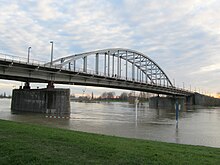John Frost Bridge
| John Frost Bridge | |
|---|---|
 |
|
| Coordinates | 51°58′29″N 5°54′43″E / 51.97472°N 5.91194°ECoordinates: 51°58′29″N 5°54′43″E / 51.97472°N 5.91194°E |
| Crosses | Lower Rhine |
| History | |
| Opened | 1948 |
John Frost Bridge (John Frostbrug in Dutch) is the road bridge over the Lower Rhine at Arnhem, in the Netherlands. The bridge is named after Major-General John Dutton Frost (1912–1993), who commanded the British forces that reached and defended the bridge during the Battle of Arnhem in September 1944. The bridge was featured in the 1977 film A Bridge Too Far, although a different bridge was used for the film.
There had been a floating bridge at Arnhem since 1603 but as the city grew in the early 20th century a permanent link across the Lower Rhine was needed. The Rijnbrug (literally Rhine bridge) was constructed between 1932 and 1935, but was destroyed by Dutch engineers in 1940 to slow the German advance during the invasion of the Netherlands. The Germans had need of the bridge however, and a pontoon bridge acted as a temporary replacement while the road bridge was repaired. The bridge was finished in August 1944.
In September 1944 the Allies launched Operation Market Garden. The road bridge across the Lower Rhine should have been the final objective of the operation, and its capture was tasked to the British 1st Airborne Division. Unexpected German resistance in Arnhem meant that only a small force of some 740 men were able to reach the northern end of the bridge, commanded by Lt-Colonel John Frost. On the night of the 17 September the British attempted to take the southern end of the bridge, using a flame thrower to destroy German positions in the bridge's towers. This accidentally ignited an ammunition store and the fresh paint on the bridge caught fire, illuminating the area for most of the night and forcing the British to abandon their attempt.
The German forces in Arnhem eventually overwhelmed Frost's men, although this took several days. They had however succeeded in closing the bridge to German armour for some four days, twice as long as a whole division was expected to hold the bridge. The rest of the division held out at nearby Oosterbeek until 25 September before being evacuated across the river.
...
Wikipedia
